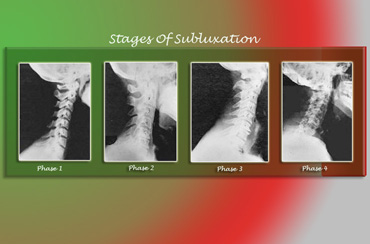Patient Education
More and more people are living longer. Check out this website for more information on how to live a your ideal 100 year lifestyle. The 100 year lifestyle

Subluxation
When one or more vertebrae lose their normal position, they interfere with the nerves they were meant to protect. This interference can cause pressure or irritation on the spinal cord and/or on the nerve roots as they pass out of the spinal column. This misalignment of the vertebrae and pinching of the nerves is called a subluxation and is the most common aspect of what doctors call the vertebral subluxation complex. Headache, pain at the base of the skull, pain or numbness of the face, stiffness or loss of normal movement of the neck, neck pain, shoulder, arm and hand problems including pain, numbness and loss of strength and nerve related problems involving eyes, ears, nose and throat. Tension between the shoulders, mid-back pain, pain wrapping around rib cage, problems affecting the heart, lungs, stomach, gall bladder, and other digestive organs. Low back pain, pain in the legs, disc problems, hip pain, groin pain, lower abdominal pain, bladder and bowel problems, many different reproductive problems, and circulation problems in the lower body. Pain at the base of the spine, bladder and bowel problems, hip pain, and sacroiliac pain
Degeneration
One of the most effective ways to determine the amount of care needed is by assessing the damage or degeneration of the spine. With trauma, the damage can be sudden but degeneration or wear and tear of the spine often occurs slowly and without symptoms.
Other Chiropractic Conditions
| Sciatica | Fibromyalgia | Carpal Tunnel |
| Osteoporosis | Tension Headaches | Migraine Headaches |
| Cluster Headaches | Whiplash | Torticollis |
| Bursitis | Osteoarthritis | Ear Infection |
| Asthma | TMJ | Low Back Pain |
Nervous System
There is a vital connection between your Spinal Column and Nervous System.Scoliosis
|
Everyone's spine has natural curves. These curves round our shoulders and make our lower back curve slightly inward. But some people have spines that also curve from side to side. Unlike poor posture, these curves can't be corrected simply by learning to stand up straight. This condition of side-to-side spinal curves is called scoliosis. On an X-ray, the spine of an individual with scoliosis looks more like an "S" or a "C" than a straight line. Some of the bones in a scoliotic spine also may have rotated slightly, making the person's waist or shoulders appear uneven. Who gets scoliosis? Scoliosis affects a small percentage of the population, approximately 2 percent. However, scoliosis runs in families. If someone in a family has scoliosis, the likelihood of an incidence is much higher - approximately 20 percent. If anyone in your family has curvature of the spine, you should be examined for scoliosis. * Children - The vast majority of scoliosis is "idiopathic," meaning its cause is unknown. It usually develops in middle or late childhood, before puberty, and is seen more often in girls than boys. Though scoliosis can occur in children with cerebral palsy, muscular dystrophy, spinal bifida and other miscellaneous conditions, most scoliosis is found in otherwise healthy youngsters. * Adults - Scoliosis usually develops during childhood, but it also can occur in adults. Adult scoliosis may represent the progression of a condition that actually began in childhood, and was not diagnosed or treated while the person was still growing. What might have started out as a slight or moderate curve has progressed in the absence of treatment. In other instances, adult scoliosis can be caused by the degenerative changes of the spine. Other spinal deformities such as kyphosis or round back are associated with the common problem of osteoporosis (bone softening) involving the elderly. As more and more people reach old age in the U.S., the incidence of scoliosis and kyphosis is expected to increase. If allowed to progress, in severe cases adult scoliosis can lead to chronic severe back pain, deformity, and difficulty in breathing.
|
|||